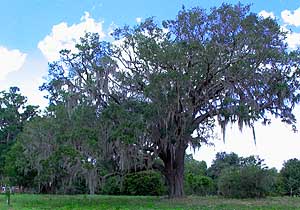Home > Health and maintenance > Solve problems > Top of canopy dying
Top of canopy dying back

Die-back or decline of the canopy can occur quickly or over a period of a decade or more. There may be numerous reasons for the top of the canopy dying back or declining including the following:
- Roots were cut during construction or grade changes. Irrigate the root zone and mulch the area under the canopy.
- Soil was added over the root system. There is little that can be done if this occurred many years ago and tree is large. If soil was added a short time ago (last year or so) removing the soil without damaging roots may help.
- Soil is compacted from pedestrian or vehicle traffic.
- Drought may be killing the tree. Consider applying irrigation to the soil under the canopy. See: applying irrigation.
- The area may have been flooded for a period of time several years ago.
- The region may have experienced strong winds within the last year or two, perhaps from a hurricane. Twigs may have died back from salty air blowing against the canopy.
- The tree may be infected with a vascular disease that is reducing water flow to the top portion of the tree.
- The trees may have run out of usable soil space. There is little that can be done.
- Tree may be subjected to persisant wind or salt spray.
- Newly planted tree is underwatered or has a poor root system.
- A root is girdling the trunk. See: root girding trunk.
- Roots are infected with armillaria or some other root infecting fungus. There is little that can be done to solve this problem. See: Armillaria.
- Lower trunk and roots are infected with ganoderma. See: Ganoderma.
- Low branches may be choking off the center top portion of the canopy. See: choking branches. This appears most common on opposite branched trees. Once die-back has occurred there is little that can be done about this. Preventive pruning to put good structure in the tree when it is young is the best way to prevent this from happening.
- See: diagnosing insect, pest, and disease problems.
Here are possible solutions
- Soil can be loosened and organic matter can be incorporated into the root zone with an air excavation tool to promote root growth. See: air excavation tool.
- Soil can be irrigated.
- Grass and shrubs can be removed from under the canopy.
- Mulch (3 to 4 inches deep) can be applied under the entire canopy, but keep it 12 inches from trunk and exposed roots next to trunk.
- Under certain circumstances, a light application to the root zone (1 pound of nitrogen per thousand square feet) of the correct fertilizer can improve health.
- Soil and mulch can be removed from the root flare. None should be touching the trunk or the tops of major roots where they meet the trunk.
- Root disease can be controlled to some extent.

